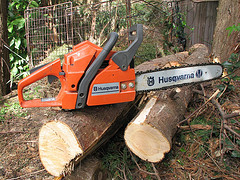
If the chainsaw is not cutting properly, then it is probably due to one of four problems.
(Courtesy: Michael Davison at flickr.com)
Just like any machine there will be times when your chainsaw does not perform as it’s supposed to. One major problem you may confront is that the gadget is not cutting properly.
When a chainsaw experiences cutting problems it is probably due to one of these issues:
· A problem with the cutting teeth.
· A guide bar issue.
· Improper chain tension.
· A clutch problem.
To better understand the problem you need to know how a chainsaw works. The common chainsaw includes a body, a 2-cycle engine, a gas tank, handles, a guide bar, a clutch and chain (also known as teeth) that fit around the bar.
As the chainsaw is running the chain or teeth rotates around the guide bar at high speed, which permits the teeth to cut through wood. Gasoline is used to commonly power the machine. However, there are also electric and battery-operated versions available. There are various lengths of guide bars and chains. The length you use depends on what type of cutting you assign the chainsaw to perform.
Problems with the teeth occur due to regular wear and tear. Simply put, the chainsaw teeth wear down or get dull. If the teeth are dull, then the chain will drag through wood. This is due to uneven wear of the teeth and it tends to cause the chainsaw to pull in one direction or the other or to produce sawdust when it cuts instead of wood chips.
To ascertain if this is the problem, check the teeth to make certain that they are all in place, that a tooth is not missing and that all the teeth are sharp. If this is the problem, simply sharpen the chain or have a professional sharpen it for you.
If the chain does not appear to be the problem, check out the guide bar to see if it is bent or worn down. Place the chainsaw on a hard, level surface and look down its length as if you are looking down the barrel of a gun. If it appears to lean to either side, then replace it with a new one. If the bar appears straight, then examine for wear along the edges of the bar. You can prevent this problem from occurring by simply turning the bar regularly to assure that wear is spread evenly.
If the guide bar is not the culprit, then the chain may need to be adjusted. If the chain is too loose, it can come off and could cause injury. If the chain is too tight, then it won’t move easily around the guide bar. Pull on the chain in the middle of the top of the bar. You should not be able to remove the chain from the bar and it should fit on the bottom of the bar without sagging. If the chain is too tight or loose, adjust it by loosening the nuts that hold the bar in place, then tighten or loosen the bar’s adjustment screw as necessary and then re-tighten the guide bar nuts.
If everything still appears okay, then the clutch may be the problem. Chainsaws include a clutch band. It is a steel band that wraps around the clutch drum and engaged by the emergency stop lever. The chainsaw cannot cut properly if the lever is not completely disengaged. Adjust the lever so that it disengages properly and adjust the clutch band if necessary.





